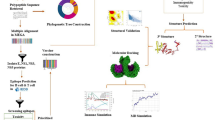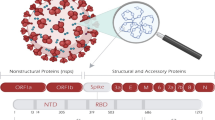Abstract
An in silico study was conducted to identify antigens with potential possibility of being a vaccine against type 1 diabetes mellitus (T1DM). A molecular mimicry between protein 2C of coxsackievirus B4 and autoantigen glutamic acid decarboxylase 65 is a significant factor in the pathogenesis of T1DM. The aim of this study was to predict the protein 2C of coxsackievirus B4 epitopes and design a vaccine against T1DM. Several web servers were used to predict continuous B cell epitopes and 8 peptides (P1–P8) were selected. Then the 3D structure of P2C was built by structural modeling using Robetta and the structure was subjected to 10 ns molecular dynamics simulation by Amber to obtain an average structure in an explicit water system. Molecular mimicry theory was confirmed by local structural alignment of modeled structure protein 2C with glutamic acid decarboxylase 65 using Swiss pdb viewer. Then conformational B cell epitope web servers were used to identify discontinuous B cells epitopes. PDBsum was used for the analysis of the protein 2C secondary structure. Finally, T cells epitopes have been predicted by the immune epitope database analysis resource (IEDB). In silico analysis of the sequence and structure retrieved by mentioned methods and web servers, revealed that two out of 8 peptides (P2 and P7 epitopes) are the best choices for the vaccine design. These results suggest that epitopes and structural features of the protein 2C of coxsackievirus B4 can be predicted and this information could be used to make novel vaccines for control of T1DM.




Similar content being viewed by others
References
Ahmad S, Gromiha M, Fawareh H, Sarai A (2004) ASAView: database and tool for solvent accessibility representation in proteins. BMC Bioinform 5:51
Atkinson MA, Bowman MA, Campbell L, Darrow BL, Kaufman DL, Maclaren NK (1994) Cellular immunity to a determinant common to glutamate decarboxylase and coxsackie virus in insulin-dependent diabetes. J Clin Investig 94:2125
Bach JF (1994) Insulin-dependent diabetes mellitus as an autoimmune disease. Endocr Rev 15:516–542
Bergamin CS, Dib SA (2015) Enterovirus and type 1 diabetes: What is the matter? World J Diabetes 6:828
Blomqvist M et al (2002) Rotavirus infections and development of diabetes-associated autoantibodies during the first 2 years of life. Clin Exp Immunol 128:511–515
Boettler T, von Herrath M (2011) Protection against or triggering of Type 1 diabetes? Different roles for viral infections. Expert Rev Clin Immunol 7:45–53
Case DA et al (2005) The Amber biomolecular simulation programs. J Comput Chem 26:1668–1688
Case D et al (2015) AMBER 2015. University of California, San Francisco
Chen J, Liu H, Yang J, Chou KC (2007) Prediction of linear B-cell epitopes using amino acid pair antigenicity scale. Amino Acids 33:423–428
Chen P, Rayner S, Hu KH (2011) Advances of bioinformatics tools applied in virus epitopes prediction. Virologica Sinica 26:1–7
Coppieters KT, Boettler T, von Herrath M (2012) Virus infections in type 1 diabetes. Cold Spring Harb Perspect Med 2:a007682
Diaz-Horta O, Baj A, Maccari G, Salvatoni A, Toniolo A (2012) Enteroviruses and causality of type 1 diabetes: how close are we? Pediatr Diabetes 13:92–99
EL-Manzalawy Y, Dobbs D, Honavar V (2008) Predicting linear B-cell epitopes using string kernels. J Mol Recognit 21:243–255
Emini EA, Hughes JV, Perlow D, Boger J (1985) Induction of hepatitis A virus-neutralizing antibody by a virus-specific synthetic peptide. J Virol 55:836–839
Essmann U, Perera L, Berkowitz ML, Darden T, Lee H, Pedersen LG (1995) A smooth particle mesh Ewald method. J Chem Phys 103:8577–8593
Florea L, Halldorsson B, Kohlbacher O, Schwartz R, Hoffman S, Istrail S (2003) Epitope prediction algorithms for peptide-based vaccine design. In: Bioinformatics Conference, 2003. CSB 2003. Proceedings of the 2003 IEEE, 2003. IEEE, pp 17–26
Gale E (2008) Congenital rubella: citation virus or viral cause of type 1 diabetes? Diabetologia 51:1559–1566
Gamble D, Taylor K (1969) Seasonal incidence of diabetes mellitus. Bmj 3:631–633
Ganjalikhany MR, Ranjbar B, Taghavi AH, Moghadam TT (2012) Functional motions of Candida antarctica lipase B: a survey through open-close conformation. PloS One 7:e40327
Ghazarian L, Diana J, Simoni Y, Beaudoin L, Lehuen A (2013) Prevention or acceleration of type 1 diabetes by viruses. Cell Mol Life Sci 70:239–255
Guex N, Peitsch MC (1997) SWISS-MODEL and the Swiss-Pdb viewer: an environment for comparative protein modeling. Electrophoresis 18:2714–2723
He Y, Rappuoli R, De Groot AS, Chen RT (2010) Emerging vaccine informatics. J BioMed Biotchnol 2010:218590
Hober D, Sauter P (2010) Pathogenesis of type 1 diabetes mellitus: interplay between enterovirus and host nature reviews. Endocrinology 6:279–289
Hornak V, Abel R, Okur A, Strockbine B, Roitberg A, Simmerling C (2006) Comparison of multiple Amber force fields and development of improved protein backbone parameters. Proteins Struct Funct Bioinform 65:712–725
Hou J, Said C, Franchi D, Dockstader P, Chatterjee NK (1994) Antibodies to glutamic acid decarboxylase and P2-C peptides in sera from coxsackie virus B4-infected mice and IDDM patients. Diabetes 43:1260–1266
Idrees S, Ashfaq UA (2013) Structural analysis and epitope prediction of HCV E1 protein isolated in Pakistan: an in silico approach. Virol J 10:113
Jaidane H, Hober D (2008) Role of coxsackievirus B4 in the pathogenesis of type 1 diabetes. Diabetes Metab 34:537–548
Janin J, Wodak S, Levitt M, Maigret B (1978) Conformation of amino acid side-chains in proteins. J Mol Biol 125:357–386
Karplus P, Schulz G (1985) Prediction of chain flexibility in proteins Naturwissenschaften 72:212–213
Karvonen M, Viik-Kajander M, Moltchanova E, Libman I, LaPorte R, Tuomilehto J (2000) Incidence of childhood type 1 diabetes worldwide. Diabetes Mondiale (DiaMond) Project Group. Diabetes Care 23:1516–1526
Kaufman D, Erlander M, Clare-Salzler M, Atkinson M, Maclaren N, Tobin A (1992) Autoimmunity to two forms of glutamate decarboxylase in insulin-dependent diabetes mellitus. J Clin Invest 89:283
Kolaskar A, Tongaonkar PC (1990) A semi-empirical method for prediction of antigenic determinants on protein antigens. FEBS Lett 276:172–174
Kringelum JV, Lundegaard C, Lund O, Nielsen M (2012) Reliable B cell epitope predictions: impacts of method development and improved benchmarking. PLoS Comput Biol 8:e1002829
Larsen JE, Lund O, Nielsen M (2006) Improved method for predicting linear B-cell epitopes. Immunome Res 2:2
Laskowski RA (2009) PDBsum new things. Nucleic acids Res 37:D355–D359
Laskowski RA, MacArthur MW, Moss DS, Thornton JM (1993) PROCHECK: a program to check the stereochemical quality of protein structures. J Appl Crystallogr 26:283–291
Lönnrot M, Hyöty H, Knip M, Roivainen M, Kulmala P, Leinikki P, Åkerblom H (1996) Antibody cross-reactivity induced by the homologous regions in glutamic acid decarboxylase (GAD65) and 2C protein of coxsackievirus B4. Clin Exp Immunol 104:398–405
MacLaren N, Schatz D, Drash A, Grave G (1989) Initial pathogenic events in IDDM. Diabetes 38:534–538
Mahdavi M, Mohabatkar H, Keyhanfar M, Jafarian A, Dehkordi MR (2012) Linear and Conformational B Cell Epitope Prediction of the HER 2 ECD-Subdomain III by in silico Methods. Asian Pac J Cancer Prev 13:3053–3059
Mohabatkar H (2007) Prediction of epitopes and structural properties of Iranian HPV-16 E6 by bioinformatics methods. Asian Pac J Cancer Prev 8:602–606
Movahedi AR, Hampson DJ (2008) New ways to identify novel bacterial antigens for vaccine development. Vet Microbiol 131:1–13
Nair S, Kukreja N, Singh BP, Arora N (2011) Identification of B cell epitopes of alcohol dehydrogenase allergen of Curvularia lunata. PloS One 6:e20020
Nielsen M, Lundegaard C, Lund O (2007) Prediction of MHC class II binding affinity using SMM-align, a novel stabilization matrix alignment method. BMC Bioinform 8:238
Parker J, Guo D, Hodges R (1986) New hydrophilicity scale derived from high-performance liquid chromatography peptide retention data: correlation of predicted surface residues with antigenicity and X-ray-derived accessible sites. Biochemistry 25:5425–5432
Pellequer JL, Westhof E, Van Regenmortel MH (1993) Correlation between the location of antigenic sites and the prediction of turns in proteins. Immunol Lett 36:83–99
Peters B et al (2005) The immune epitope database and analysis resource: from vision to blueprint. PLoS Biol 3:e91
Ponder JW, Case DA (2003) Force fields for protein simulations. Adv Protein Chem 66:27–85
Ponnuswamy P, Prabhakaran M, Manavalan P (1980) Hydrophobic packing and spatial arrangement of amino acid residues in globular proteins Biochimica et Biophysica Acta (BBA)-Protein. Structure 623:301–316
Ponomarenko J, Bui HH, Li W, Fusseder N, Bourne PE, Sette A, Peters B (2008) ElliPro: a new structure-based tool for the prediction of antibody epitopes. BMC Bioinform 9:514
Raman S et al (2009) Structure prediction for CASP8 with all-atom refinement using Rosetta. Proteins Struct Funct Bioinform 77:89–99
Redondo MJ, Rewers M, Yu L, Garg S, Pilcher CC, Elliott RB, Eisenbarth GS (1999) Genetic determination of islet cell autoimmunity in monozygotic twin, dizygotic twin, and non-twin siblings of patients with type 1 diabetes: prospective twin study. Bmj 318:698–702
Roivainen M, Klingel K (2010) Virus infections and type 1 diabetes risk. Curr DiabRep 10:350–356
Ryckaert JP, Ciccotti G, Berendsen HJ (1977) Numerical integration of the cartesian equations of motion of a system with constraints: molecular dynamics of n-alkanes. J Comput Phys 23:327–341
Saha S, Raghava G (2004) BcePred: Prediction of continuous B-cell epitopes in antigenic sequences using physico-chemical properties. Artificial immune systems. Springer, Berlin, pp 197–204
Saha S, Raghava G (2006) Prediction of continuous B-cell epitopes in an antigen using recurrent neural network Proteins: structure. Funct Bioinform 65:40–48
Salomon-Ferrer R, Case DA, Walker RC (2013) An overview of the Amber biomolecular simulation package. Wiley Interdiscip Rev Comput Mole Sci 3:198–210
Schloot N, Roep B, Wegmann D, Yu L, Wang T, Eisenbarth G (1997) T-cell reactivity to GAD65 peptide sequences shared with coxsackie virus protein in recent-onset IDDM, post-onset IDDM patients and control subjects. Diabetologia 40:332–338
Schloot N, Willemen S, Duinkerken G, Drijfhout J, De Vries R, Roep B (2001) Molecular mimicry in type 1 diabetes mellitus revisited: T-cell clones to GAD65 peptides with sequence homology to Coxsackie or proinsulin peptides do not crossreact with homologous counterpart. Hum Immunol 62:299–309
Schranz DB, Lernmark Å (1998) Immunology in diabetes: an update. Metab Rev 14:3–29
Sharma V, Kalim S, Srivastava MK, Nanda S, Mishra S (2009) Oxidative stress and coxsackievirus infections as mediators of beta cell damage: a review. Sci Res Essays 4:42–58
Song Y et al (2013) High-resolution comparative modeling with RosettaCM. Structure 21:1735–1742
Srikanta S, Ricker A, McCulloch D, Soeldner J, Eisenbarth G, Palmer J (1986) Autoimmunity to insulin, beta cell dysfunction, and development of insulin-dependent diabetes mellitus. Diabetes 35:139–142
Steck AK, Rewers MJ (2011) Genetics of type 1 diabetes. Clin Chem 57:176–185
Sun J et al (2009) SEPPA: a computational server for spatial epitope prediction of protein antigens. Nucleic Acids Res 37:W612–W616
Tan EL, Wong APY, Poh CL (2010) Development of potential antiviral strategy against coxsackievirus B4. Virus Res 150:85–92
Tian J, Lehmann PV, Kaufman DL (1994) T cell cross-reactivity between coxsackievirus and glutamate decarboxylase is associated with a murine diabetes susceptibility allele. J Exp Med 180:1979–1984
Varela-Calvino R, Sgarbi G, Arif S, Peakman M (2000) T-Cell reactivity to the P2C nonstructural protein of a diabetogenic strain of coxsackievirus B4. Virology 274:56–64
Vreugdenhil G, Geluk A, Ottenhoff T, Melchers W, Roep B, Galama J (1998) Molecular mimicry in diabetes mellitus: the homologous domain in coxsackie B virus protein 2C and islet autoantigen GAD65 is highly conserved in the coxsackie B-like enteroviruses and binds to the diabetes associated HLA-DR3 molecule. Diabetologia 41:40–46
Vreugdenhil GR, Batstra MR, Aanstoot HJ, Melchers WJ, Galama J (1999) Analysis of antibody responses against Coxsackie virus B4 protein 2C and the diabetes autoantigen GAD65. J Med Virol 59:256–261
Acknowledgement
This research is supported by University of Isfahan (Grant No: 97886/90).
Author information
Authors and Affiliations
Corresponding author
Electronic supplementary material
Below is the link to the electronic supplementary material.
13721_2016_112_MOESM4_ESM.pdf
Figure S4: Accessible surface area plot for modeled P2C. Colour index: Blue: Positive charged residues (R, K, H), Red: Negative charged residues (D, E), Green: Polar uncharged residues (G, N, Y, Q, S, T, W), Yellow: Cysteine, Gray: Hydrophobic residues (All others) (PDF 33 kb)
Rights and permissions
About this article
Cite this article
Taherzadeh, M., Esmaeili, A. & Ganjalikhany, M.R. In silico vaccine design against type 1 diabetes based on molecular modeling of coxsackievirus B4 epitopes. Netw Model Anal Health Inform Bioinforma 5, 5 (2016). https://doi.org/10.1007/s13721-016-0112-y
Received:
Revised:
Accepted:
Published:
DOI: https://doi.org/10.1007/s13721-016-0112-y




